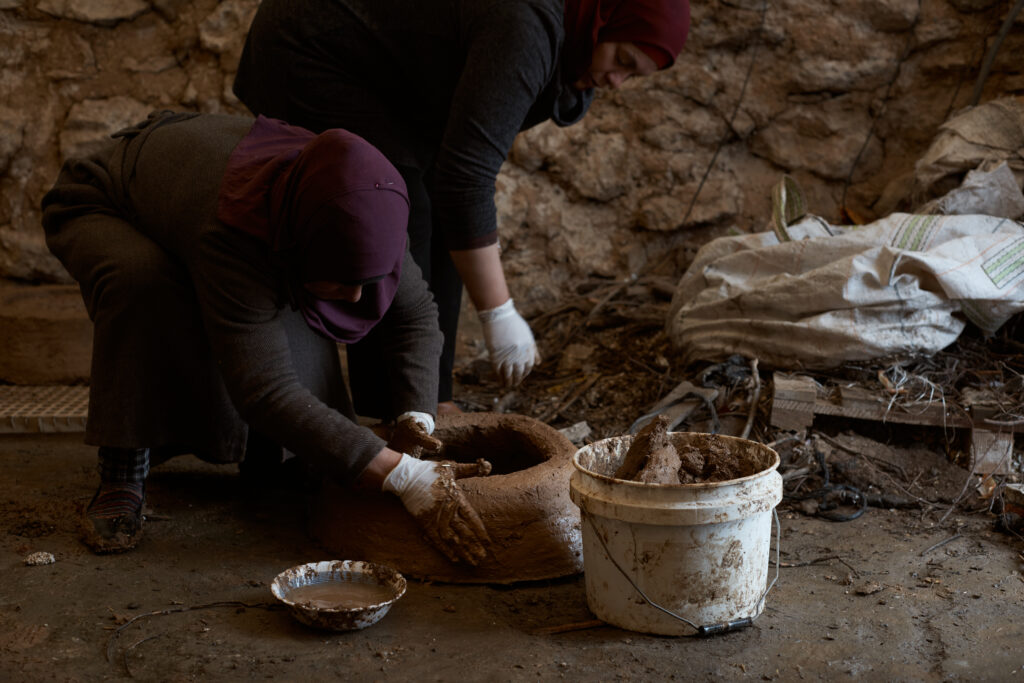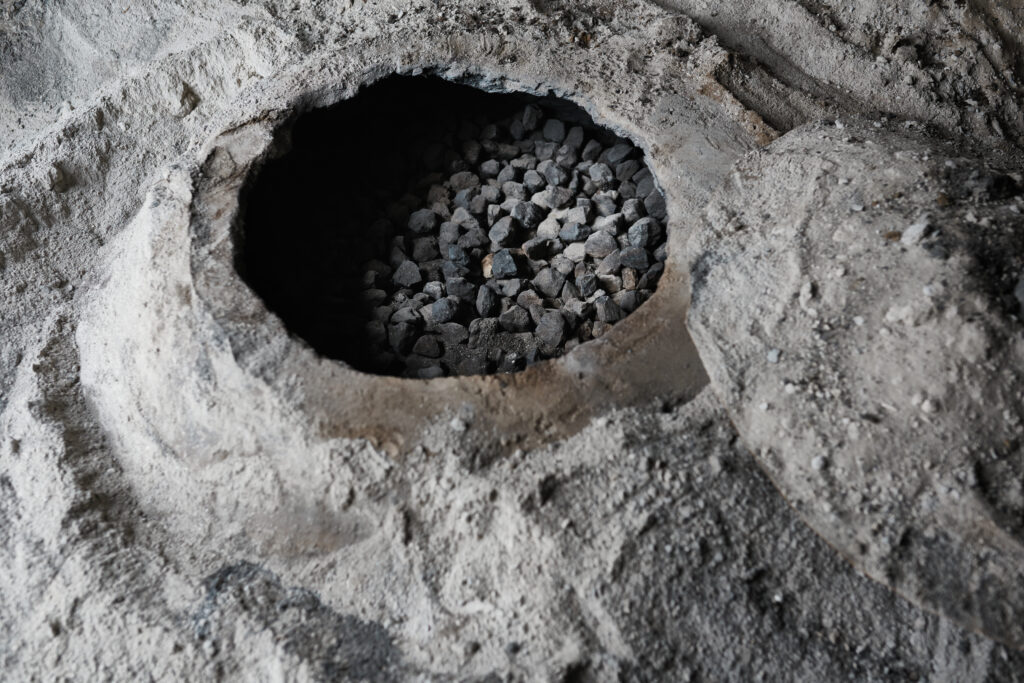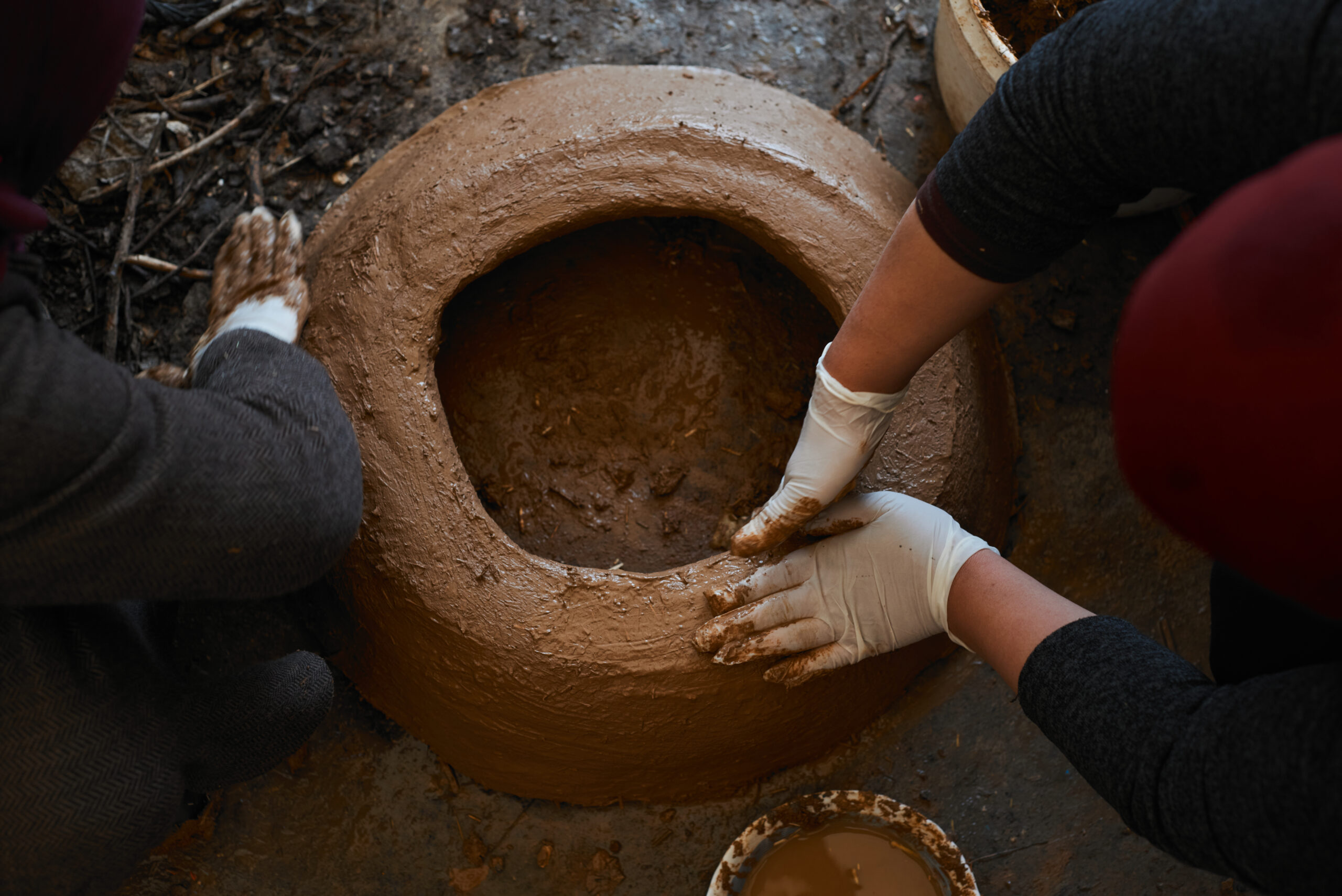Wadad Nawaja’a, from the Palestinian village of Susya, builds her clay taboon the same way her mother, grandmother, and great grandmother, and many generations before them did. On a freezing cold day last winter, I accompanied Wadad to her Bedouin village south of Hebron, to learn about this ancient craft, which is a disappearing tradition.

Wadad begins by locating a suitable soil, which she then transports in pails to a little shed she uses as a storehouse. There she mixes it with water to make mud, adding chopped straw and kneading the mixture with her skilled hands to help it come together.
When she reaches the desired texture, she begins building the taboon — a process that takes several days: she adds muds, shapes, and smooths it, leaves it to dry for two days, and repeats these steps as needed. The result is a hollow structure shaped like a truncated cone, about 50 cm (20 inches) in diameter. A metal lid with a long handle is used to cover its top round opening.

Once the taboon is completely dry, Wadad digs a hole called a kahf (which is sometimes dug on an elevated platform) and fills it with broken glass and salt, which will store heat. A metal plate is placed on top of the hole, and the taboon is set on it. Finally, a layer of pebbles is spread on the taboon’s floor to maximize the generated heat and the entire structure is placed in a small tin shack, also called taboon, to help store heat and keep out rain and humidity.
Firing the Taboon
The taboon is then buried in olive or dry animal waste, which also gives the taboon its Arabic name – zaballe, meaning waste or olive pomace. Before being used for the first time, the taboon is fired and then buried in ash for two days, to create heat using embers alone, with no direct fire. From that moment on, the fire is maintained constantly: each evening the taboon is fed with more fuel and buried in ash, so it is ready for use the next day. If a taboon is kept dry, it can last for years.

Taboon-baked flatbreads have a unique shape and flavor taking on the shape of the pebbles placed on its bottom, and adopting a smoky flavor. The ovens are also used for roasting and for slow cooked-stews, which take on the same signature smoky flavor.
A Little History
Cooking became an everyday habit about 200,000 years ago. At the time, meats and other foods were cooked over an open, direct fire. Simple areas dedicated for cooking (like fire pits) begin appearing in the Akkadian Empire (Mesopotamia, between the Tigris and Euphrates rivers) more than 4,000 years ago, and in the Pharaonic kingdom in the third millennium BCE. This type of cooking is what we now know as a barbecue or a bonfire – kanunu in Akkadian, a word still used today in Arabic: كانون , kanun.
More sophisticated cooking installations appeared in Mesopotamia in a later period — called tannur (تنور) in Arabic, tanura in Persian, tanur in Turkish and tandur in Urdu, they are probably the forefathers of today’s taboon.
The ancient tannur was a cylindrical structure, less than one meter (40 inches) high, with a round opening on top. Fuel was placed on its bottom, and the first breads in human history — flatbreads made with no yeast — were baked against its thin, clay walls. At times, pots or other cooking utensils were placed on top. Examples of such ovens were found in archaeological excavations in Caesarea on the coast and inland in Yokne’am, and they are still widely used in Iraq, Turkey, Georgia, and India.

With the discovery of the magic of yeast, people began adding beer or fermented food to their dough. The leavened dough, however, was unsuitable for baking in a tannur: it required a moist environment, and the familiar, round clay taboon was invented.
In the past, two kinds of taboons were used in the territory of present-day Israel: the first is the type that Wadad makes, a clay oven buried in ashes with no direct fire source — hence its name (the word taboon is thought to be related to covering or hiding, as the fire is covered with soil and ashes to keep the taboon lit). The second is taboon wakadeh, a cylindrical oven with a side opening, and room for stocking wood in its lower part, offering it direct heat. This kind of taboon exists today in some rural areas locally and is used to bake pita, laffa and more.
Both kinds of taboons were built inside small shacks, which stood in the yard and were shared by several households. They were probably removed from the living areas because of unpleasant odors and smoke that come from burning animal and olive waste.With the emergence of cities and the development of community brick ovens and bakeries, taboons remained in use only in rural areas. In the early 20th century, German photographer and priest Gustaf Dalman documented many ovens of this kind in Palestine, but today they are very rarely used. One can find them mostly in Gaza, where they became prevalent as a result of the siege and the shortage in fuel and building materials, as well as in villages in the Palestinian Territories, in rural areas in the Upper Nile area in Egypt, in Sudan and in villages in Tunisia and Algeria.


